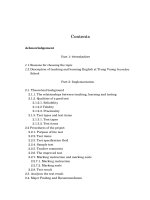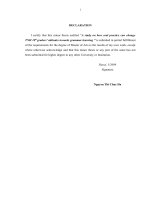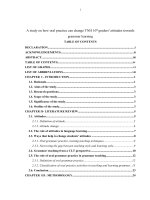a study on epoxidised natural rubber
Bạn đang xem bản rút gọn của tài liệu. Xem và tải ngay bản đầy đủ của tài liệu tại đây (301.06 KB, 9 trang )
1
A STUDY ON EPOXIDISED NATURAL RUBBER FOR POSSIBLE
APPLICATION IN TUBELESS TYRE INNER LINER
Roland Ngeow
#
, Khaw Pei Chin and Che Su Mt Saad
Technology & Engineering Division, Rubber Research Institute of Malaysia,
Malaysian Rubber Board, 47000 Sungai Buloh, Selangor, Malaysia.
#
Corresponding author. Tel.: +6 (0)3 6156 1121; fax: +6 (0)3 6156 4418;
E-mail address:
ABSTRACT
Epoxidised Natural Rubber containing 50 mole % epoxidation (ENR 50) has been
shown to have unique set of properties. One of these properties is reflected in
vulcanisates with excellent air retention characteristics which is comparable to that of
butyl rubber. A low air permeability characteristic is important for tubeless tyre inner
liner to ensure the performance and durability of the tyre during service. Other
requirements for tyre inner liner compound are good processibility and good physical
properties. In this paper, ENR 50 is studied and compared with blends of ENR 50 and
SMR 20 at different ratios. Natural Rubber (NR) possesses good processing properties
including high green strength, as well as excellent cured physical properties.
Keywords: Epoxidised natural rubber (ENR), ENR 50, tyre, inner liner
1.1 Introduction
Epoxidised Natural Rubber (ENR) is produced by modification of natural rubber
(NR) latex. In general, the desire % mole epoxidation can be achieved at any level,
however only two grades are available commercially. These grades are marketed as
Ekoprena 25 and Ekoprena 50 by Malaysian Rubber Board for ENR 25 and ENR 50
with epoxide contents of 25 % mole and 50 % mole respectively. The epoxidation of
NR has progressively reduced the air permeability ability of NR as the % mole
epoxidation increased. Studies has found that the air retention characteristic of ENR 50
is as good as halogenated butyl rubber which is an important requirement of tubeless
tyre inner liner application
1,2
.
Tyre inner liner is used for air barrier in the inner surface of a tyre to retain the
internal tyre pressure. Tyre with inflation pressure at optimum level ensure the
durability and performance of a tyre, resulting in better performance in term of better
fuel economy, handling and ride compared to tyre that is not inflated at optimum
pressure. Besides that, tyre with optimum pressure can prolongs the tyre carcass and
tread lives and contributes to even tread wear. According to French tyres manufacturer
- Michelin, the rolling resistance of a tyre is accounts for 20% - 30% energy
consumption in an average vehicle
3,4
and 25% of world wide carbon dioxide emissions
are generated by road traffic
4
. This showed that maintaining the optimised inflation
pressure of a tyre plays an important role in our environment.
2
Other requirements for tyre inner liner compound are good processibility and
physical properties. The compound must be easily calendered to give smooth and even
thickness during tyre manufacturing process. NR is known of possessing good
processing characteristics and high green strength. Blending NR with ENR 50 provides
compound that exhibits the unique qualities of these respective polymers for tyre inner
liner application and promote the usage of sustainable materials for tyre compound
development.
According to International Rubber Study Group, 44% of 22.7 million tonnes of
world rubber consumption is source from natural rubber in year 2009
5
and majority of
this rubber is used for the tyre industry. Tyre inner liner compound occupied
approximately 5% of the total tyre weight. In general synthetic rubber such as
halogenated butyl rubber (HIIR) is conventionally used for tyre inner liner. Replacing
part of the tyre components with sustainable materials will greatly reduce the usage of
our depleting natural resources and meeting the stringent carbon dioxide gas emission
regulations made by policy makers.
In this study, ENR 50 is blend with NR to obtain the optimum properties for
tubeless tyre inner liner application. Further study is carried out to compare ENR 50/
NR blend at 70 : 30 % by weight with Bromobutyl (BIIR) compounds.
2.1 Material and Method
2.2 Preparation of ENR/ NR Compounds
Raw rubbers ENR 50 and SMR 20 are obtained from Malaysian Rubber Board. All
the vulcanisates are prepared according to standard techniques. Laboratory Banbury
mixer size 1.6 L (BRL600) is used to blend the polymers and chemicals. The mixer is
set at 110 r.p.m. rotor speed and the initial temperature is set at 70
o
C with 0.7 filled
factor. The mixing cycle is as follows for ENR 50/ NR blend:
0 min : Add polymers + calcium stearate
½ min : Add powders (zinc oxide, stearic acid, antioxidant, etc.)
1 min : Add Carbon Black (CB) and processing oil
2 ½ min : Sweep down feed chute
3 ½ min : Dump
In all the ENR 50/ NR compounds preparation, insoluble sulphur and accelerators
are added later on a Carter 9” x 18” two-roll mill and the compounds are cured to
optimum (t
95
) at 150
0
C using electrical press. The semi-EV ENR 50/ NR tyre inner
liner formulation employed in this study is shown in Table 1:
3
Table 1: ENR 50/ NR Tyre Inner Liner Formulations
Ingredient p.p.h.r.
Polymers 100
Calcium Stearate 2
Zinc Oxide 4
Stearic Acid 2
Carbon Black N660 55
Escorez Resin 5
Tudalen 65 10
Santoflex 13 1
Permanax TMQ 1
Insoluble Sulphur 0.7
TBBS 1.8
The ratios of ENR 50 and NR blends are shown in Table 2. ENR 50 are taken as
control. Six compounds are prepared and shown in Table 2.
Table 2: ENR 50/ NR Blend Ratios Used for Tyre Inner Liner Study
The physical testing procedures are done in accordance to the International
Standard Organisation (ISO) or British Standard.
2.3 Scanning Electron Microscope (SEM) Analysis
Joel FESEM JSM 6701F model is used in this study for morphology analysis. The
instrument is operated at 2kV with 15mm working distance. The analysis is based on
semi-quantitative measurement of element extracted from a specific window size.
Samples are placed onto the specimen stub and examined by evaporative coating with
ultra-thin layer of platinum under high vacumm which provided a conducting layer that
permits SEM examinations.
2.4 Filler Dispersion Analysis
Reflective Light Microscope disperGrader+
TM
of Dynisco is used to measure the
filler dispersion. Samples are cut to generate a ‘fresh face’ for analysis. By utilising the
reflected light method, the disperGrader scanned the samples surface, measured and
quantify filler dispersion and agglomerate size. The ‘flat areas’ are seen as black (no
reflected light) and agglomerates reflect light to the sensor and are seen as grey to
white. This device is complies with ISO 11345 with 30x magnification.
Polymer Polymer Ratio
1 2 3 4 5 6
ENR 50 100 80 70 65 60 50
NR 0 20 30 35 40 50
4
3.1 Results and Discussions
3.2 Processing Properties
Understanding the processing properties of compound are important in the tyre
industry to ensure the consistency and quality of the final product. Table 3 showed the
processing properties of ENR 50/ NR compounds.
Table 3: Processing Properties of ENR 50/ NR Compounds
From Table 3, the cure time (t
95
) decreased with increasing NR contents in general
except for compound 4 and compound 6. This may due to the homogeneity of the
blends. It is observed that NR has an effect on the cure time (t
95
) and the Mooney
Scorch (t
5
) of the compounds. It is noteworthy that in general, the cure time (t
95
) and
the Mooney Scorch (t
5
) are reduced when NR contents increased.
The rheographs of compounds are shown in Figure 1. Compound 1 consists of ENR
50 without any blend with NR showed the lowest minimum torque. From the figure, it
is clear that compound 1 is undergoing cure reversion which is not good for tyre
application. However, it is no longer observed when NR is incorporated into ENR 50. It
is postulated that NR increases the crosslink density in the rubber matrix due to higher
double bond density in NR and improves the cure reversion resistance of ENR 50/ NR
compounds.
Figure 1: Rheographs of Compounds
Processing Properties Compound
1 2 3 4 5 6
Compound Viscosity
(ML 1+4 at 100
o
C)
37.7 35.1 36.2 37.1 36.5 37.2
Mooney Scorch, t
5
(Min: Sec t 120
o
C) 22:15 21:29 20:51 20:41 20:23 19:52
Rheo Cure, t
95
(Min: Sec) 4:48 4:37 4:32 4:40 4:15 4:18
0
1
2
3
4
5
6
7
0 500 1000 1500 2000
Time (Second)
Torque (dNm)
Compound 1
Compound 2
Compound 3
Compound 4
Compound 5
Compound 6
Torque (dNm)
Time (second)
5
3.3 Scanning Electron Microscope (SEM) Analysis
The physical properties of the blends are largely determined by phase morphology
and compatibility. These effects are particularly marked with regard to air permeability
efficiency, tear strength and elongation at break. SEM micrographs of ENR 50/ NR
compounds at different blend ratios are presented in Figure 2.
Figure 2: SEM Micrographs of Compounds
ENR 50/ NR at 100:0 % by weight showed finer morphology with relatively
smooth surface compared with the rest of the compounds due to the presence of single
polymer.
In the 65:35 %, 60:40 % and 50:50 % by weight of ENR 50/ NR compounds, the
rough surfaces became apparent and higher number appearance of agglomeration are
observed in the rubber matrix when ENR 50 contents decreased. The morphology of
these blends indicates that the continuous phase of ENR 50 components are reducing
and moving towards the co-continuous phase between ENR 50 and NR components.
The SEM morphology study indicates lower chemicals dispersion rates when ENR 50
contents decrease.









